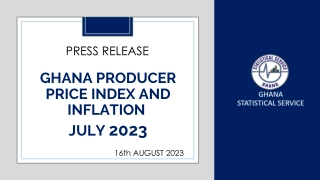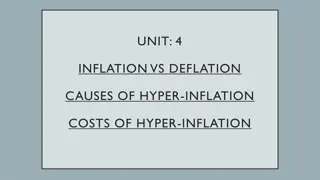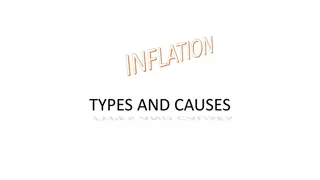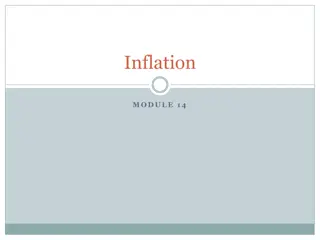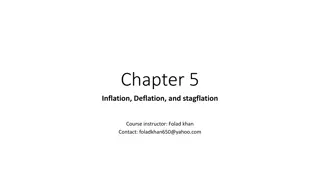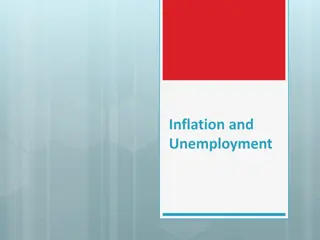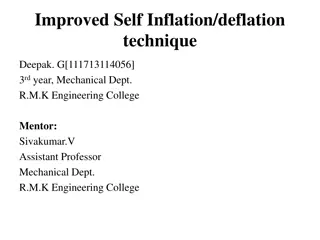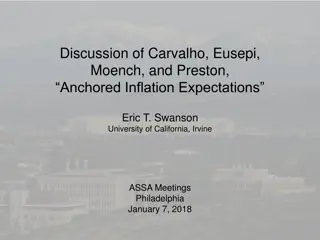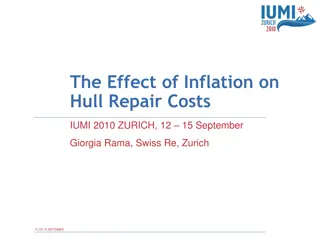Understanding Inflation Rates and Payback Periods in Financial Analysis
Delve into the concepts of inflation rates, payback periods, and consumer price index calculations with practical examples. Learn how inflation affects purchasing power over time and how to calculate average inflation rates. Explore equivalence calculations under inflation to understand the impact on dollar amounts, both actual and constant across time periods.
Download Presentation

Please find below an Image/Link to download the presentation.
The content on the website is provided AS IS for your information and personal use only. It may not be sold, licensed, or shared on other websites without obtaining consent from the author. Download presentation by click this link. If you encounter any issues during the download, it is possible that the publisher has removed the file from their server.
E N D
Presentation Transcript
IET 333 Week 5: Inflation rates Payback periods Jung-woo Sohn (jzs177@psu.edu) College of Information Sciences and Technology Penn State University
Announcements Midterm exam #1: October 9th, Thursday class time Go over the slides and HW #1 More detailed specific steps than HW #1 Multiple choices, fill-in-the-blanks, short answers Derivation: Sum of arithmetic series, geometric seris Sum of equal payments: (?/?,?,?) Check your Angel e-mail setup! Under Preference System settings Forwarding address and forwarding mode!
Feedback from the survey: Students need: Industry jobs IET 333 as a required course Course refinements: More real-world examples Then go back to abstract theories More exercises Pace of lectures: okay Math skills required: okay Clarity of slides: okay on average Advanced track possible Others: L and R Speak slowly!
Inflation What is inflation? The same dollar buys less of an item over time What is the effect? Loss in the purchasing power over time
Consumer Price Index: CPI How is inflation rate calculated? The dollar amount of buying a basketful of goods Food, housing, apparel, transportation, medical care, etc. CPI in US: based on 1982-84 dollar amount of $100 ???2 ???1=?????2 ?????1 ???1is often 100
Average inflation rate Same as effective interest rates calculation Example: 4% inflation for the first year, 8% for second year $100 1 + 0.04 1 + 0.08 = $100 1 + ?2 Or $100 1 + 0.04 1 + 0.08 = $100(?/?,?,2) 5.98% General inflation rate: when we use CPI for calculation ????= ???01 + ?? ???0: base period, ????: CPI at the end of period ? 1 ? 1 For consecutive years: ??= ???? ???0 Or ? = ???? ???? 1 1 or ??=???? ???? 1 ???? 1
Equivalence calculations under inflation Actual (current) dollar Dollar amounts including the impact from inflation Constant dollar (base-year dollar) Value constant independent of the inflation Dollar amounts at time period 0 So far, we assumed:
Equivalence calculations under inflation Market and inflation-free interest rates Market interest rates (APR, ?) Nominal interest rate Includes inflation: Actual dollar Inflation-free interest rates (? ) Does not include inflation: Constant dollar Relationship between APR and ? ? Discounting to present value ( ?: avg. inflation rate): ? = ? 1+?? Therefore, ? = 1 + ? Most of time, ? ? = 0 ? = ? ? Example: APR 10%, inflation rate 2% ? ?? ? 1+ ??/ 1 + ? ? Or ? = 1 + ? = ? + ? + ? ?
Equivalence calculations under inflation: Deflation method Convert values to constant dollars, then present worth Convert values to constant dollars, then present worth Inflation rate ? = 5% Inflation-free interest rate ? = 10% n Net cash flow in actual dollars 0 -$75,000 1 $32,000 2 $35,700 3 $32,800 4 $29,000 5 $58,000
Equivalence calculations under inflation: Deflation method Actual dollars -$75,000 $32,000 $35,700 $32,800 $29,000 $58,000 Constant dollars -$75,000 $30,476 $32,381 $28,334 $23,853 $45,455 Present worth -$75,000 $27,706 $26,761 $21,288 $16,295 $28,218
Equivalence calculations under inflation: Deflation method Actual dollars -$75,000 $32,000 $35,700 $32,800 $29,000 $58,000 Present worth -$75,000 $27,706 $26,761 $21,288 $16,295 $28,218
Payback periods: Definition Duration in which an investment pays for itself Break-even point Example: Constant cashflow A tool changer purchased at $5,000 Generates $2,000 profit per year 2.5 years of payback periods
Payback periods: Example: variable cashflows A hydraulic machine is installed at a cost of $5,000. Its gross income and operating costs are given as in the table. What will be the payback period for this machine? Year Gross income Operating cost 1 $3,500 $1,100 2 $3,350 $1,200 3 $3,600 $1,250 4 $3,200 $1,300 5 $3,450 $1,400 6 $3,400 $1,500 7 $3,350 $1,600
Payback periods: Example: variable cashflows Year Gross income Operating cost Net income Cumulative income 1 $3,500 $1,100 $2,400 $2,400 2 $3,350 $1,200 $2,150 $4,550 3 $3,600 $1,250 $2,350 $6,900 4 $3,200 $1,300 5 $3,450 $1,400 6 $3,400 $1,500 7 $3,350 $1,600 Payback period: 2 +5000 4550 2.19 years 2350
Time-valued payback periods A hydraulic machine example: (annual interest 10%) Year Cashflow in present worth Year Cashflow 0 -$5,000 0 -$5,000 1 $2,200 1 $2,000 2 $2,200 2 $1,818 3 $2,200 3 $1,653 $2,200 4 $2,200 5 $2,200 6 Payback period = 2 + 1182/1653 = 2.71 years
Payback periods and decision- makings Alternative projects Merits and limitations of payback periods Pros: Simpler to use Suitable for small investments Quicker investment decision Projects involving rapidly changing technologies Easily understood Cons: Time value of money ignored An approximate, less exact method
More on decision-makings: microeconomics Diminishing marginal returns: Consume preference and utility functions



